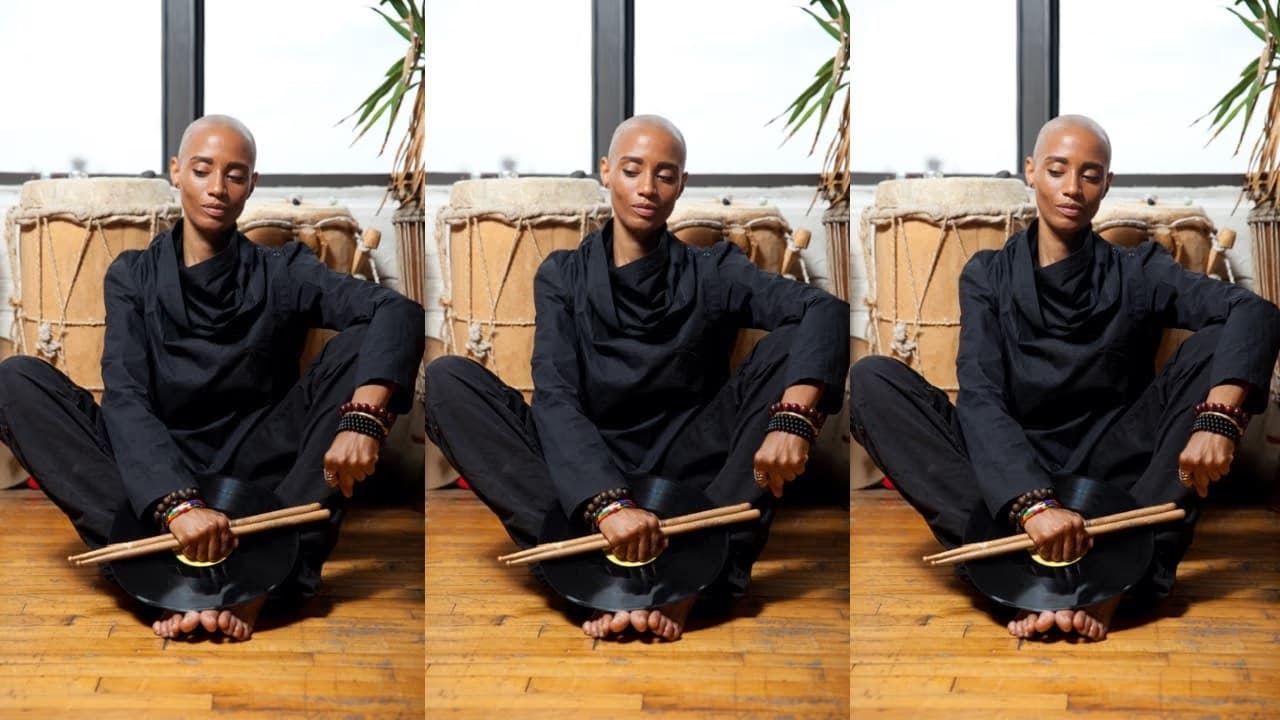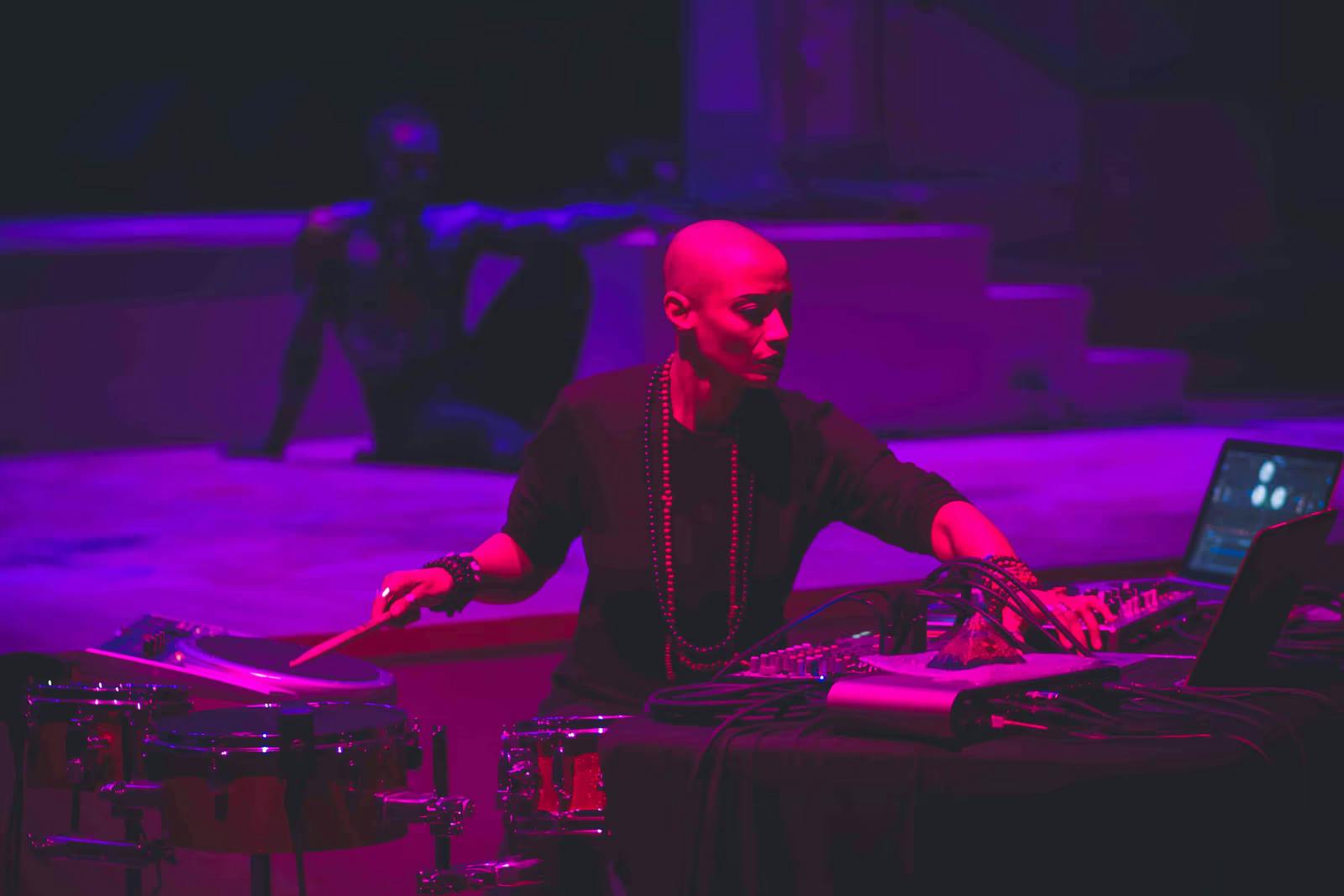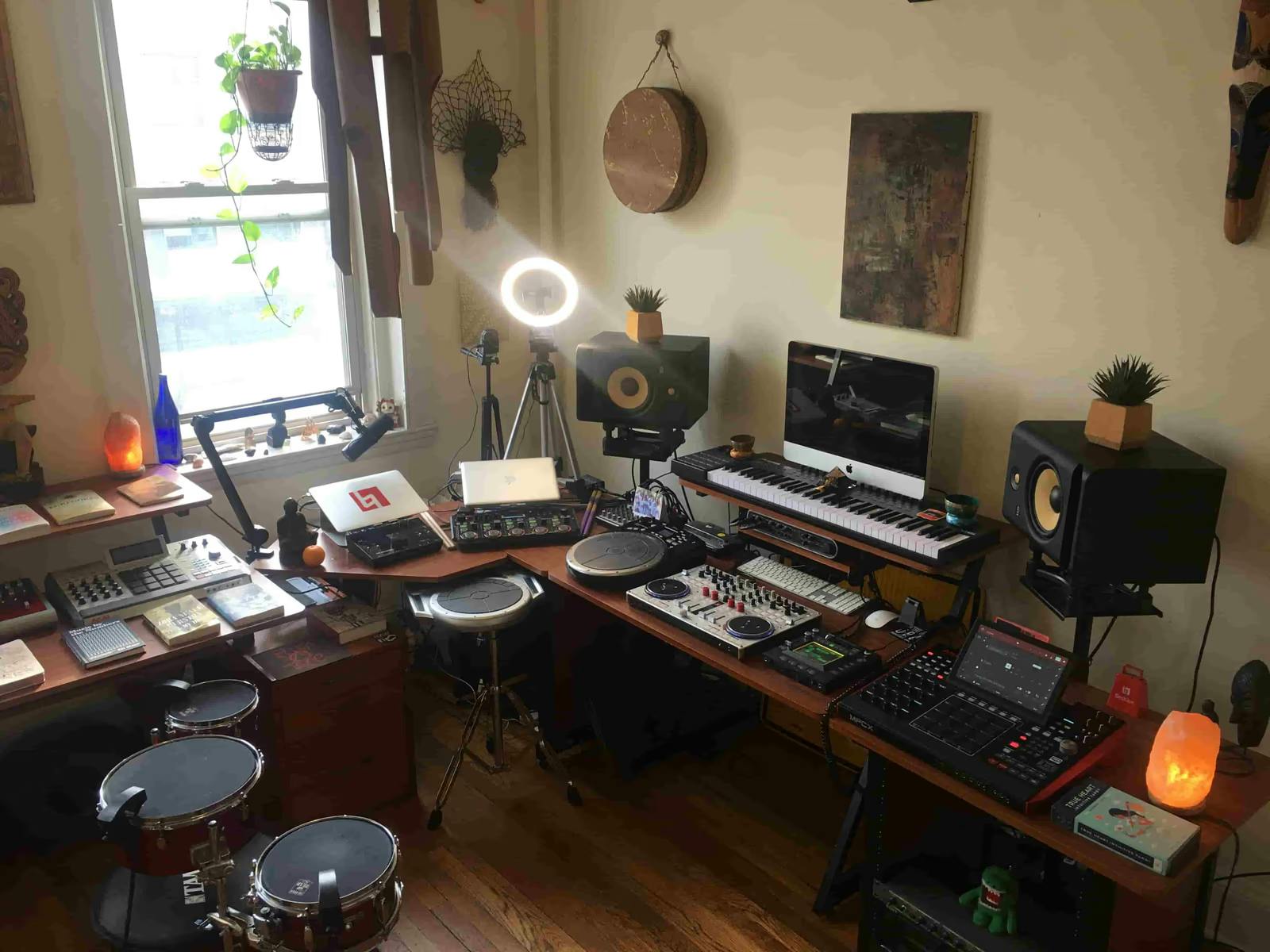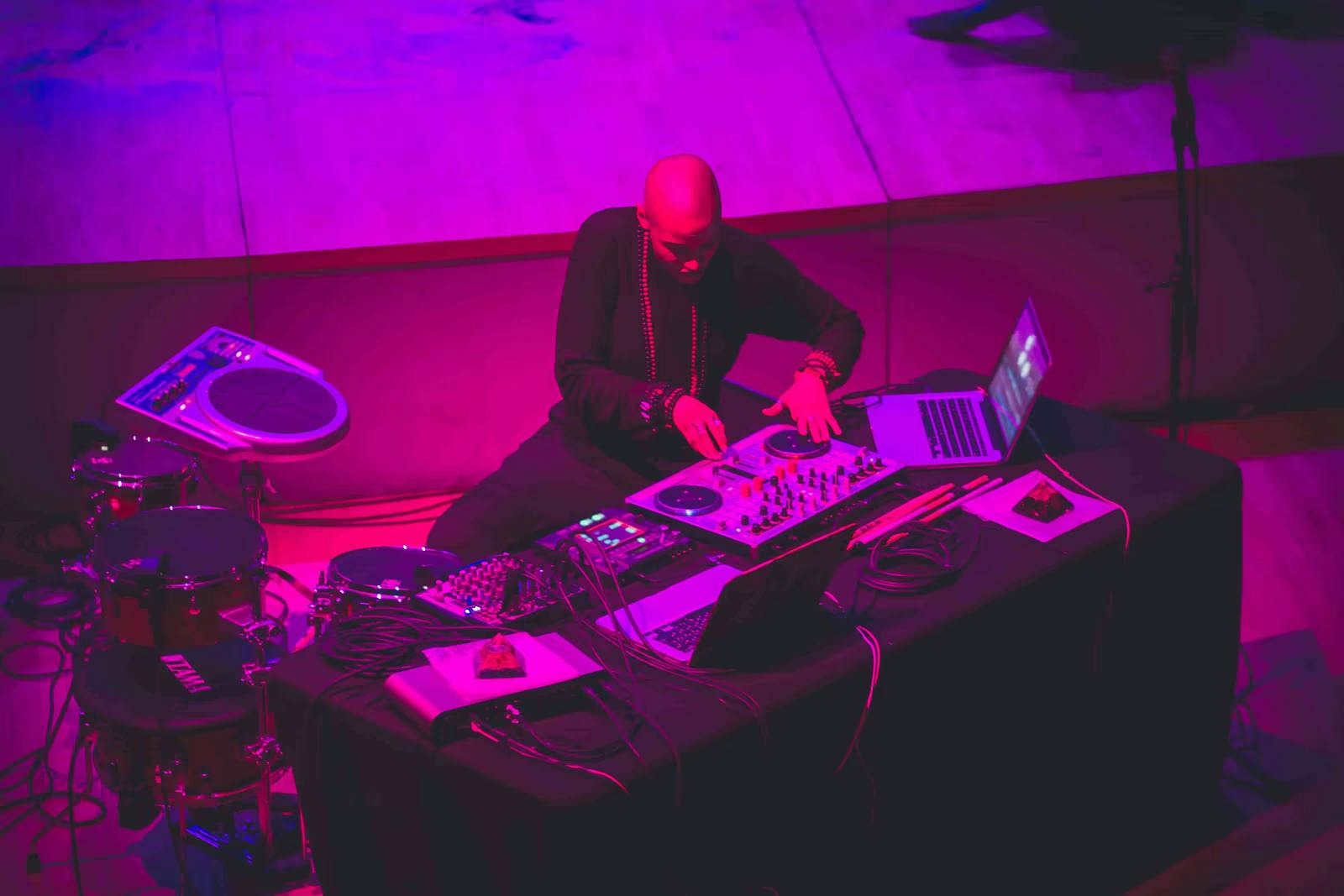
Haitian born and Brooklyn based, Val Jeanty is a Afro-Electronic music composer, drummer and turntablist. Her installations have been showcased at The Whitney Museum, The Moma, The Lincoln Center in New York City, and internationally at The Biennale in Venice and SaalFelden Jazzfest in Austria.
NYSCA fellowship 2019 recipient she has worked with a diverse group of artists including Anthony Braxton, Craig Taiborn, Andrew Cyrille, Vernon Reid and the late great Geri Allen. Other highlights include “Fascinating Her Resilience” a Wesleyan University commissioned multimedia performance collaboration with professor Gina Ulysse and with Afro-Cuban bassist Yosvany Terry on his Grammy nominated album “New Throned King”.
We videochatted with Val on January 15, 2021 to talk about her musical background, recent work, and how she incorporates technology into her music.
I read that you began playing drums at the age of four or five. Do you remember what drew you to the drums?
I come from a vodou culture family. So that's what drew me to drums: it picks you. Everyone picks a role in the culture, so my role was drumming. Drumming was always my thing and it makes me feel like I'm alive! And because of vodou culture I was exposed to it very, very, very, very young.
When we would have the rituals around the yard, what we call the lakou, and festivals like the Gede Festival: our own version of Halloween where we honor the dead, there's a lot of drumming. And in Gede the style of drumming is called Petwo, and I would compare Petwo to techno: superfast! Petwo is like fire!

So when you're around that kind of family and that culture you can't help but just get soaked in it! And that's how I got zapped into it. From there I've always kept going because it made me feel like I was alive, and the only way I could express myself was with the drums.
I started playing at four or five, and my Grandma, she's the Mambo: the priestess for the rituals, so of course they let me play [laughs] because it's family.
And it's a great way to allow kids to play. Some kids are drumming, some kids are dancing, we have singers, some kids are learning how to cook. So it's a whole thing and it's all a way to express the spirit, and for me that's communicating through the drum.
So I didn't really say “Okay, this is the thing that I'm gonna pick,” you know? I'm four or five at this point, and so it wasn't like that at all. But even to this day I'm always searching. I'll go from the drums, to scratching, to the piano, because it's still a search. But growing up the drums felt like the only thing I was connected to. So here we are now [laughs].
And that actually leads me to my next question, since you mentioned scratching. How does drums influence your turntablism? That is, if drums has influenced your turntables style at all?
Yeah, it definitely has. Because the whole concept for me is a conga concept, right? When you see two decks, it's like these two round things. So for me, when I first saw a deck, I was like, “oh, this is congas! I can do it: it's the same thing.”
And it is the same thing, and it's not. It is in the sense that you have to do the scratches and the back and forth with your hands, and it's kind of like when you're driving a stick-shift car: one side is doing one thing (one rhythm pattern)and the other side is doing something different. But of course they're in time.
But it is different, right? It's that percussive hand action like the congas, or you could transfer it to the keys (which is also a percussive thing). And because of that perception it was easy for me to transfer.
And my other connection to scratching was from the first time I heard it was the stuttering. I was like, “wow, this sounds like me! [laughs] I have to do that, because this is how I sound when I talk!” And there's a link there because it gives folks who stutter a way to channel and musically express the intense rhythmic sounds.
You played turntables on Kris Davis' album Diatom Ribbons, which the NY Times listed as the best Jazz album of 2019: turntables are a pretty unique instrument in jazz, do you approach turntables any differently in a jazz context?
Well, it is a different approach. It's not the same approach as hip-hop. But rhythmically it is the same, but jazz is tricky and you have to catch different parts and, and be able to flow with it: it's its own language, and so once you know it, then you can slide through it, but it is different. And swing is very different from a hip-hop scratch.
I believe you coined the term Afro Electronica, what is Afro Electronica and what traditions do you bring to the genre?
Back when I was doing gigs in 2001ish through 2003ish people would ask me after the gig, “what is this? what is it?” And so just to keep it simple I called it Afro Electronica because it is African-Hatian, and it is electronics. It's vodou culture expressed in the now.
How has Sensory Percussion been incorporated into your various workflows?
Sensory Percussion has been such a blessing, such an amazing tool.
I have a thing that I call “Octopus Syndrome” [laughs]. It's a multi-instrumentalist thing where I go from here to there quickly without having to stop: “Now I'm going to play drums,” and you have to go here, “now I'm going to scratch,” and I have to go there…and it just helps to have all these zones on the drums.
I'm exploring and I just love it! And it's been so great during quarantine, which is the perfect time to practice, and it helps to stay in the flow, to keep the ideas going: to not have to stop and check the software, which breaks up the flow. I never have to look at the software.
Val's Studio Setup

- Tama Cocktail Kit
- Four sensors
- Macbook Pro (late 2013)
- Vestax 380 (turntable controller)
- Serato DJ Pro (software)
- M-Audio Air 192/14 (main I/O for Sensory)
- Boss RC 505 (loop station)
- Handsonic HPD-20 (Roland)
- Korg Kaossilator pro + (loops)
- MPC X (Akai)
- Logic Pro X and/or Pro Tools 10 (recording/mixing/mastering)
- KRK speakers
I just love experimenting with the sensors, it's been amazing. I have the sensors here in my studio on a cocktail kit, which is all one unit, and so when I hit the drums the whole thing shakes and causes these...mistakes, but perfect mistakes, and I love that! It's raw art and you're exploring a whole world of sound.
Yeah, and that's an aspect that we've discussed a lot at Sunhouse: sympathetic resonance, and is all crosstalk bad crosstalk? Of course you don't want certain types of sounds to misfire, but in the real world when you hit a drum that's right next to another drum both drums vibrate and both produce sound. So there are features that allow people to control the amount of crosstalk they want and to allow certain sounds to vibrate sympathetically, while other sounds require a more deliberate hit to trigger.
And that's where it's at for me! And for the spirit of art, I feel that you need those subtle things that just connect without you forcing it. I just love it!
Diving into some more of your more recent work: In November of 2019 you performed at Roulette, what was that performance like?
It was a full on ritual, basically. It was all improv, and there were dancers and the instruction was just to be in the spirit of the unknown, so no one knew what was going to happen and we just captured the vibe happening in the room.

My dancers were all painted, dripping and I had my kit there as well as the turntables: the whole octopus thing! And the dancers were getting closer and closer to my kit and I would think “oh no, no, no, that's too close!” and one of the dancers was stomping and Sensory Percussion was picking it up, but it was perfect!
Fodder, a collaboration you did with Poet Douglas Kearney is coming out this year, how did that come together?
That was part of a grant from the Regional Arts and Culture Council and it was strictly improv and Douglas is an amazing, amazing poet. And the whole project was done with Sensory Percussion: I just told him to have a kit with mesh heads there and we did a sound check and improvised the performance: we were going HAM!
You are also a professor at Berklee College of Music. What drew you to teaching?
Oh, I've been teaching for a long time. From 2004 to 2015 I was teaching at this place called The Door, which is an amazing youth center and it has a DJ program, a beat making and finger drumming class. And I've always been such a gearhead and so the students would come to class and learn how to DJ and learn how to play beats, and they loved the technology, because hip-hop is their world.
And now it's such an honor to be part of the Electronic Production and Design (EPD) program at Berklee. And my students are amazing! And what I bring there is: stepping away from pressing buttons and actually playing and working with those mistakes. And it's just been incredible to see my students just charge right through quarantine and stay focused. I was just blown away by their final project! It's a great feeling!
What techniques and sounds do you gravitate towards when you perform/record?
Sonically, it could be anything, really. It could be the wind, it could be birds, but I often stick to vodou culture or something that is related to the culture and a mixture of everything I've learned here: Jazz, Techno, House. But when it comes to drums, that's all Hatian Vodou, which exists in all those genres, too. When I hear the swing rhythm in Jazz, to me that's vodou. It's just a matter of perception and adjusting your ear.
